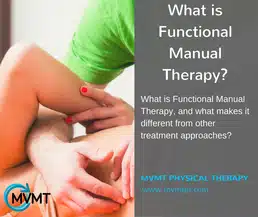What is Functional Manual Therapy?

Physical Therapy is a broad and diverse profession. Even within the specialty of Orthopedic PT, treatments may vary greatly – largely due to the variety of Continuing Education offerings today and to the interests and skills of the individual Therapist. Therapists may be influenced by their own athletic interests, education, clinical instruction, or personal injury history. At MVMT, treatments are heavily influenced by the FMT (Functional Manual Therapy) approach, along with other assessment and treatment styles.
So – what is Functional Manual Therapy and why is it different from other approaches?
Functional Manual Therapy, or FMT, developed by Gregg and Vicky Johnson at the Institute of Physical Art, is based on three pillars of treatment: Mechanical, Neuromuscular and Motor Control. The approach is a systematic framework of assessment of functional movement patterns, active treatment and a reassessment. FMT is constantly changing and heavily influenced by research and other treatment techniques. Many times, a patient who is new to this style of treatment is immediately struck by how different it is, and wants to know more about the approach. So, a high-level look at FMT:
Mechanical, while it may seem obvious, addresses the “parts of the machine” of the human body. From this standpoint, we address the mobility of fascia, ligaments and tendons, muscle, joints, and even the viscera and nervous system. By incorporating Functional Mobilizations – an active mobilization of the part in question – the patient is now an active participant in their own treatment, rather than a passive recipient of therapy.
The Neuromuscular component considers the connection between the brain and the muscle. A simple analogy: the brain is the computer; our nerves are the wiring of the system; muscles are the electrical equivalent of a lightbulb. The computer needs intact wires in order to fire up the lightbulb. Gray Cook, one of the creators of the Functional Movement Screen, has said “Movement occurs in the body, but movement patterns live in the brain”. So we utilize neuromuscular re-education to “re-write” faulty programs in the brain/computer. The keystone in this section of treatment is Proprioceptive Neuromuscular Facilitation, or PNF, and deserves more explanation that we will provide here.
Finally, Motor Control considers how well all of the pieces are put together. I often equate it with a symphony – all of the components need to be well orchestrated; otherwise we end up with discord and dysfunction. Key concepts here are coordination, sequencing, timing, and one of my favorites, efficiency.
Regardless of the training of your Therapist, there is no single correct treatment approach to address physical injuries. Some treatments work for some patients, while other techniques work for another patient. As such, we as Physical Therapists are often looking for more answers and techniques to improve our “tool box” of clinical skills. How do you find an FMT therapist? Look for the credentials CFMT – Certified Functional Manual Therapist – after their name. Or, you may find them listed on the IPA directory.
In another post, we’ll look at the alphabet soup of letters behind therapists’ names. Hint: it represents the hard work that they’re putting in BEYOND their degree!
